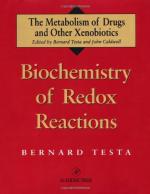|
This section contains 1,348 words (approx. 5 pages at 300 words per page) |

|
Reduction reactions are essential to life. In photosynthesis, carbon dioxide and water are reduced to form the carbohydrates required as a source of energy for plant and animal life. Photosynthesis ultimately provides all energy, with the exception of nuclear power and the relatively small contributions from solar, wind, water, and geothermal power, for human and animal life and most of the fuel used by society and industry. If research into artificial means of using sunlight to convert water and carbon dioxide into carbohydrates without the intervention of green plants succeeds, the impact on our global energy problems will be enormous.
Reduction reactions are also used by chemists to synthesize pharmaceuticals, textiles, dyes, paints, and a multitude of other important products. A major industrial use of hydrogen is the reduction of unsaturated liquid vegetable oils to make edible solid fats like margarine.
The original definition of reduction reactions centered...
|
This section contains 1,348 words (approx. 5 pages at 300 words per page) |

|


